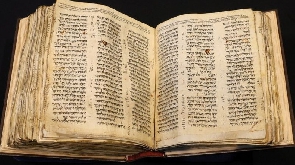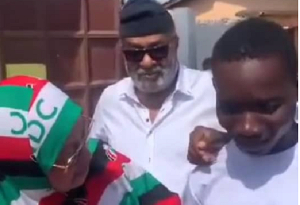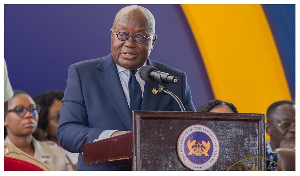Dem don buy di oldest most complete Hebrew Bible for Sotheby New York for $38.1m (£30.6m), wey make am become di most valuable manuscript dem don ever sell for auction.
Believe be say dem write di Codex Sassoon about 1,100 years ago.
Na di earliest surviving example of one single manuscript wey contain all 24 books of di Hebrew Bible wit punctuation, vowels and accents.
US lawyer and former ambassador Alfred Moses buy am for di ANU Museum of di Jewish People in Tel Aviv, Israel.
"Di Hebrew Bible na di most influential for history and make up di bedrock of Western civilisation," Oga Moses tok for one statement.
"I rejoice in knowing say e belong to di Jewish pipo. Na my mission, to realise di historic significance of Codex Sassoon, to see say e reside for a place wit global access to all pipo."
Di winning bid pass di $30.8m wey Microsoft co-founder Bill Gates pay for 1994 for di Codex Leicester, Leonardo da Vinci scientific notebook.
But e fall short of di record for one historical document dem sell at auction set by hedge fund manager Ken Griffin, wey buy one first-edition printed copy of di US constitution for $43.2m two years ago.
Dem name di Codex Sassoon afta one previous owner, David Solomon Sassoon, wey acquire am for 1929 and assemble di largest and most important private collection of Hebrew manuscripts for di world for im home for London.
Di text of di Hebrew Bible – wey im 24 books make up wetin Christians call di Old Testament - remain for flux until di early
Middle Ages, wen Jewish scholars dem sabi as Masoretes begin to create a body of notes wey standardise am.
Dem consider di Aleppo Codex, wey dem assemble around 930, as di most authoritative Masoretic text. However, as e damage from one fire for di Syrian city of Aleppo for 1947 mean say only 295 of di original 487 pages wey survive today.
Di Codex Sassoon, wey im carbon dating show say dem create am around 900, dey miss only 12 pages, according to Sotheby's.
"E present to us di first time one almost-complete book of di Hebrew Bible appear wit di vowel points, di cantillation and di notes on di bottom telling scribes how dem suppose write di correct text," Sharon Mintz, senior Jewish artefact specialist for di auction house, tok for March.
Centuries of annotations and inscriptions reveal say one man named Khalaf ben Abraham sell di manuscript to Isaac ben Ezekiel al-Attar, wey later transfer ownership to im two sons, Ezekiel and Maimon.
For di 13th Century, dem dedicate di codex to one synagogue for Makisin, for north-eastern Syria.
After either di Mongols later for di 13th Century or di Timurids for di start of di 15th Century, destroy di town, dem give di manuscript for safekeeping to Salama ibn Abi al-Fakhr. E later disappear in history for 500 years.
Di Codex Sassoon most recent owner na Swiss investor Jacqui Safra, wey buy am for £2m ($2.5m) for auction for London for 1989.
BBC Pidgin of Thursday, 18 May 2023
Source: BBC




















